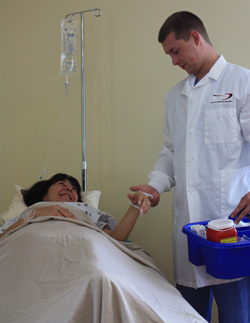Eight Questions Every Phlebotomist MUST Answer Correctly: #5
Do you adhere to proper patient ID without exception?
by Dennis Ernst • April 27, 2021

Question: What is the correct way to identify your patients?
When drawing your neighbor for lab work, do you ask her to state her name? You should. It might feel silly, but regardless of how familiar you are with any patient, they all expect you have certain policies and procedures to follow, and probably appreciate it when you don't bend the rules just for them. Patients know healthcare is serious business. When it comes to drawing a blood sample from which the physician will get most of the information they need to diagnose, treat, and medicate them, nothing is more serious than drawing the right patient. Does your facility's procedure manual instruct you to ask patients to identify every patient according to the established protocol "unless you already know who they are"? Probably not. Standards are standardized. That means you conduct the procedure the same way for everyone.
What is the proper way to identify your patient? According to CLSI, identify patients by asking them to state their full name and birth date, and to spell their first and last names. Then compare the information given with the information on the order, requisition, and identification band if available. If patients are unconscious, cognitively impaired, or have other communication barriers, have a caregiver, friend or family member provide the required information, then document the name of the verifier. Any discrepancy should be resolved and corrected prior to sample collection.
All inpatients must have an ID band, and all ID bracelets must be affixed to the person. If the bracelet is not attached, the sample should not be drawn until it is attached. In facilities that do not provide ID bands for outpatients, the patient is to provide proof of their identification, preferably a photo-ID, that bears the patient-specific identifier determined by the facility. They are also required to state their full name and date of birth and spell their first and last names, just as for inpatients. Where facility policy prevents ID bands from being place on certain inpatients (e.g., isolation patients, psych wards, etc.), the facility must establish an alternative protocol that ensures proper patient identification, and the policy must be followed.
Neighbor or stranger, everyone must be asked these questions, not just to affirm the name you verbalize for them, but to verbalize the response. Patients have died when they received incompatible blood because they thought they heard the phlebotomist state their name when it wasn't, but sounded like it. Since 11% of transfusion deaths are caused by phlebotomists who misidentify the patient or the tube, this step must be followed without exception. Not only that, don't expect every identification bracelet to contain the patient's correct information, or to even be on the right patient. Studies have found up to 16% of identification bracelets contain erroneous information. Don't trust them.
Correct answer: Every patient must state their full name and birth date, and spell their first and last names even when they're a friend, neighbor, or family member. If they can't speak for themselves, a friend, caregiver, or family member must provide the information on their behalf. The name of the verifier must be documented. The information must then be compared with the information on the order, requisition, and identification band if available. The patient must be wearing an identification band except in facilities that do not band their outpatients or where facility policy precludes their use on some inpatients.
Anxious for the rest of the questions? I've compiled all eight into one of our most popular downloads, "Eight Questions Every Phlebotomist Must Answer Correctly."
Related Posts and Information
overall rating: my rating: log in to rate
